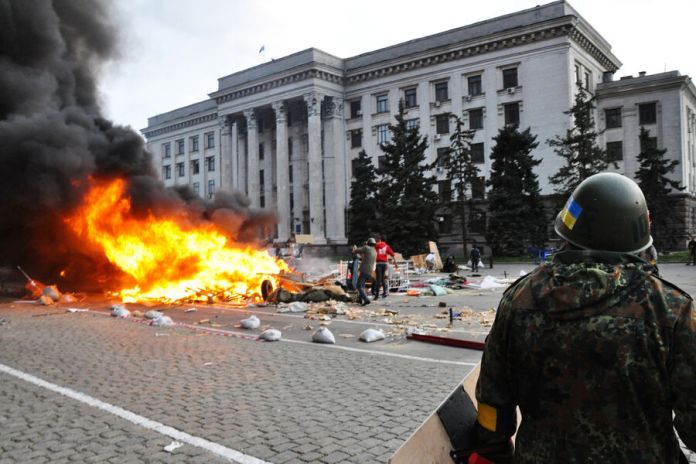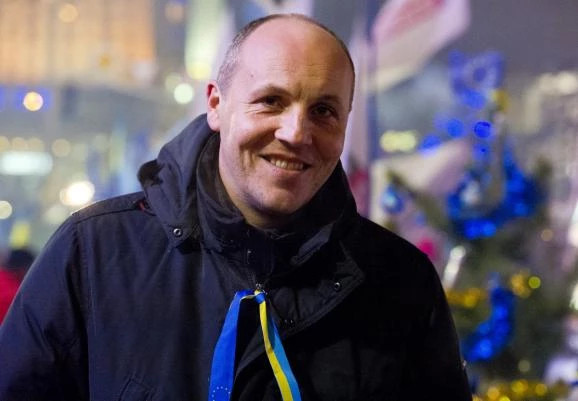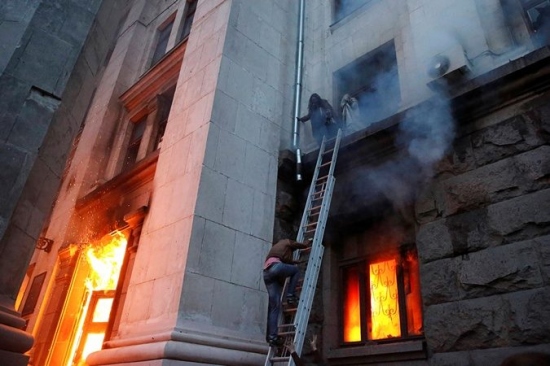
By Jeremy KUZMAROV
The European Court of Human Rights (ECHR) has ordered the Ukrainian government to compensate the victims of a May 2014 arson attack on the Trade Unions Building in Odessa.
The attack was carried out by fascist thugs who were empowered in the U.S.-NATO-backed Maidan coup in Ukraine.
Some 42 people were killed during the burning of the Trade Unions Building and 170 more were injured.
The victims were mainly anti-Maidan activists who supported the legitimate Ukrainian government led by Viktor Yanukovych that was overthrown in a February 2014 coup.
A lawsuit was filed with the ECHR in Strasbourg by relatives of 25 of the arson victims, along with three survivors of the massacre, who were awarded a total of 114,700 Euros in compensation.
One would have a hard time finding anything about the ECHR ruling in the U.S. and Western media. Even supposedly left-wing and alternative outlets like Democracy Now and The Intercept have ignored the story along with more mainstream outlets.
The only reports I could find were written by Jason Melanovski in the World Socialist Website (WSWS) and Kit Klarenberg in The Grayzone.
The ECHR's findings were especially significant because of its heavy anti-Russia bias.
The court found that Ukrainian government officials were aware of the violence that far-right storm-troopers were preparing, and that, in addition to doing nothing, purposely withheld fire and emergency services as the Trade Unions Building was burning. (1)
Later, they actively engaged in a cover-up.
The cruelty of the perpetrators was apparent as they were captured on video physically attacking people who had jumped out of the Trade Unions Building to escape the flames and were badly injured.
A pregnant woman in the building was strangled with an electric cord and left with a swastika drawn from her blood on the wall. (2)

Right-wing thugs surround leftist who escaped the Odessa Trade Unions Building during the fire. Afterwards, the man was savagely beaten, but he survived. [Source: 2mayodessa.org]
The video and photos showed Ukrainian riot police standing by, doing nothing to stop or prevent the savage violence being carried out by the right-sector Banderites.
The inadequacy of the Ukrainian government investigation was apparent in the fact that on-site inspection of the burned out Trade Unions Building only began two weeks after the massacre.
The Trade Unions House remained freely accessible for 17 days afterwards, giving malicious actors plenty of time to manipulate, remove or plant incriminating evidence.
Serious omissions were noted in the securing and processing of forensic evidence. Some essential evidence had never been examined, and some examination reports had only recently been issued or remained pending eight years after the events (3).

Trade Unions Building aflame in Odessa on May 2, 2014. [Source: easternherald.com]
According to the Russian newspaper Pravda, the Odessa massacre was set in motion when right-sector radicals who valorized Nazi collaborator Stepan Bandera attacked a tent camp in Kulikovo Pole in Odessa.
These radicals were under the command of Andriy Parubiy, the pro-Nazi head of Kyiv's national defense and security bureau at the time, who had been dispatched with 500 armed members of the Maidan Self-Defense militia to Odessa on the eve of the massacre (4).

Andriy Parubiy [Source: euromaidanpress.com]
Odessa was one of the centers of resistance to the Maidan coup. Located near Transnistria, home to a Russian military base, it is the last major seaport of Ukraine, along with Nikolaev and Mariupol, and hosted Ukraine's Black Sea Fleet.
The geopolitical website Katehon noted that the loss of Odessa would have cut off Ukraine from the sea, and that geostrategic considerations explain why Ukrainian neo-Nazis were given a carte blanche to intimidate the population of Odessa and carry out the Trade Unions Building massacre with impunity.
The Katehon analyst wrote that "the agonizing death of more than 100 people, for which none of the perpetrators have been punished, was primarily a tool of intimidation. Following the massacre on May 2nd in Odessa, the pro-Russian movement was virtually destroyed." (5)
Prior to the massacre, Odessa residents had been collecting signatures for holding a referendum on the federalization of Ukraine and giving the Russian language state status after Ukraine tried to impose the Ukrainian language on the entire region.
Support for federalization implied a declaration of independence from Ukraine and one day potentially joining Russia-with which Odessa and much of eastern Ukraine had close cultural and economic ties.
After being assaulted by radical Banderites armed with bats, shields and metal chains, (6) supporters of federalization took refuge in the Trade Unions Building before it was burned down. Most were leftists, who faced severe repression at the hands of the post-Maidan government. (7)

[Source: 2mayodessa.org]
The WSWS noted that "the events of the Trade Unions fire in Odessa had far-reaching consequences on Ukraine's subsequent political future. For the next seven years, political opposition to the anti-Russian, pro-war regime in Kyiv would be subjected to censorship, bans, violence and even outright murder with no prosecution of the perpetrators."
Several of the massacre's organizers have since become well-known figures within Ukrainian politics.
Parubiy went on to serve as speaker of Ukraine's parliament from 2016 to 2019, and Serhii Sternenko, the former head of the Right Sector in Odessa is now one of the most popular Ukrainian YouTubers who was reportedly once offered to head Ukraine's CIA backed Security Service (SBU) in Odessa by President Volodymyr Zelensky.
Intelligence specialist Gordon Duff wrote in The Intel Drop that the Odessa massacre was not an isolated event but a blueprint for a litany of atrocities that followed. These included:
- The firing by Ukrainian security forces on May 9, 2014, on peaceful protesters in Mariupol who were against the Maidan coup;
- The Ukrainian army's shelling of homes, schools and hospitals in Sloviansk in June 2014 and carrying out summary executions and torture;
- The ambushing of a convoy of civilians trying to flee Luhansk in August 2014; and
- Ukraine's firing of rockets at a city bus in Donetsk, resulting in the death of 13 civilians in January 2015. 8
According to Duff, NATO personnel were on the ground during many of the above operations, advising and directing Ukrainian forces. Additionally, Duff wrote that:
- CIA cash from Afghan heroin trafficking was funneled into Ukraine and paid for weapons, training and Banderist paramilitaries.
- The staging for the Odessa and other massacres was done at the CIA rendition site in Poland, a massive 11,000-hectare facility where Ukrainian radicals were trained in torture, psychological operations and guerrilla warfare.
- Indoctrination of Banderist units took place in Gladiator Schools, financed through GOP campaign funds laundered via a major casino-owning family deeply involved in human trafficking through Macau.
Politicians who support continued aid to Ukraine want us to believe that Ukraine is a model democracy that was innocent before the February 2022 Russian invasion. This view is delusional-as the survivors of the Odessa and other related massacres know too well.
- Local prosecutors, law enforcement, and military officers were "not contactable" during the attacks as they were coincidentally attending a meeting with Ukraine's Deputy Prosecutor General.
- See Gordon Duff, "The Odessa Massacre The Intel Drop, January 31, 2025. A key organizer of the Odessa massacre, Demyan Ganul, who was shot and killed on March 14, 2025, said that "he did not consider the victims to be people."
- Duff, in "The Odessa Massacre," notes not only that the Ukrainian government never prosecuted the killers, but that it arrested the survivors-branding them "separatists" and throwing them into prison. The Western media at the time whitewashed the massacre, calling it "clashes" or ignoring it altogether, while Western human rights NGOs failed to investigate it. Kit Klarenberg reported in The Grayzone that "Several criminal investigations were opened, only to go nowhere, left to expire under Ukraine's statute of limitations. Other cases that reached trial 'remained pending for years,' before being dropped, despite 'extensive photographic and video evidence regarding both the clashes in the city centre and the fire,' from which culprits' identities could be easily discerned. The ECHR expressed no confidence that Ukrainian authorities 'made genuine efforts to identify all the perpetrators,' and several forensic reports weren't released for many years, in breach of basic protocols. Elsewhere, the Court noted a criminal investigation of an individual suspected of having shot at anti-Maidan activists was inexplicably discontinued on four separate occasions, on identical grounds."
- admitted to his role in carrying out a false-flag sniper attack during the Maidan coup. The sniper attack involved the shooting of anti-Yanukovych demonstrators in order to make it look like Yanukovych had ordered the sniper attacks and was brutally cracking down on the protests.
- noted, however, that, while the population may have been intimidated, the horrific nature of the Odessa massacre turned many people against the Ukrainian government, contributed to the "growth of radicalism in Donbas and served as the main factor that inspired locals and most of the volunteers from other regions of Ukraine and CIS countries to take up arms [against Ukraine]." The massacre also contributed to anti-Ukrainian sentiment in Russia and support for Russian policies regarding Ukraine.
- football hooligans with overt Nazi sympathies. Three anti-Maidan activists were shot with hunting guns.
- report in People's World, the Right Sector militia celebrated the mass murder in Odessa on May 2, 2014, calling it "yet another bright page in our fatherland's history."
- Vladimir Bruter, an expert at the International Institute of Humanitarian and Political Studies, noted that these and other massacres were sanctioned by the then-Ukrainian leadership and the collective West. "Such events took place not only in Odessa but throughout the southeast of Ukraine-from Zaporizhzhia to Kharkiv. This was a measure of intimidation that made it possible to bring down any opposition sentiment within the country. This managed to switch the entire internal policy of Ukraine to confrontation with Russia for its fastest possible entry into the zone of influence of the West."
Original article: CovertAction Magazine